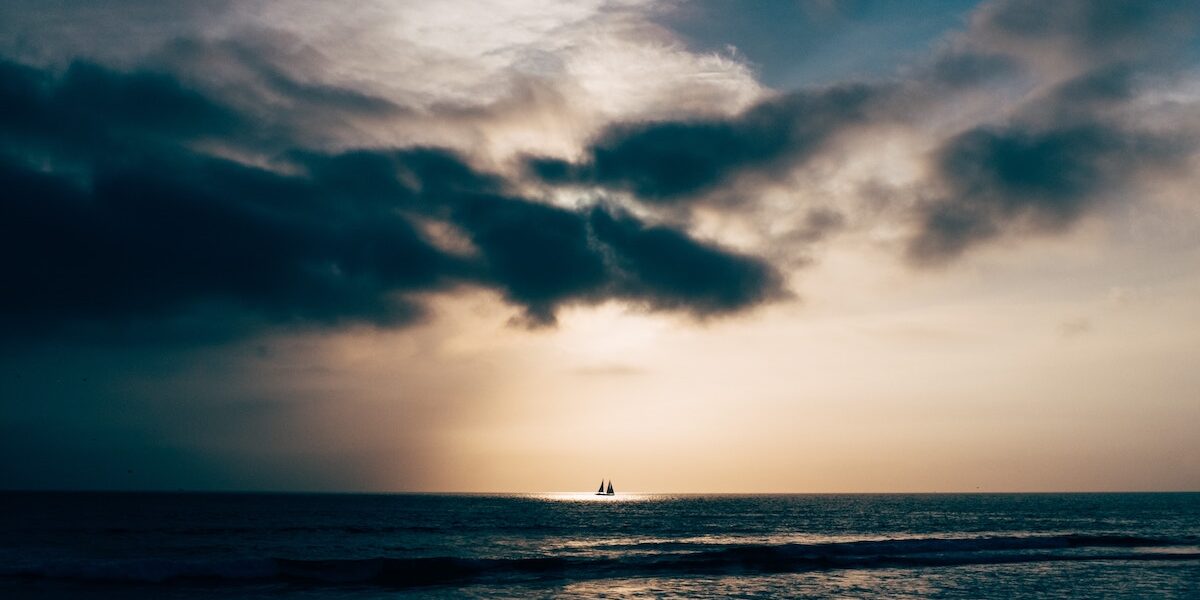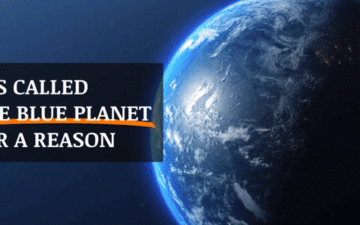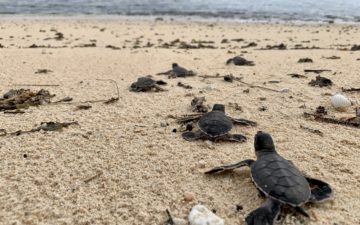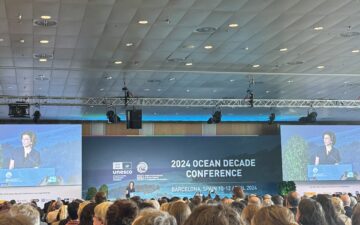By Mark J. Spalding, President, The Ocean Foundation and Caroline Coogan, Foundation Assistant, The Ocean Foundation
At The Ocean Foundation, we have been thinking a lot about consequences. We are saddened by the tragic human stories of loss in the wake of storms such as the one that struck St. Lucia, Trinidad & Tobago, and other island nations on Christmas Eve. There has been an outpouring of sympathy and assistance to those affected, just as there should be. We have been asking ourselves what are the predictable elements of the aftermath of storms and what can we do to prepare for the aftermath?
Specifically, we have also been asking ourselves how can we limit or even prevent the harm that comes from the debris that is created by flooding, wind, and storm surge damage—especially when it winds up in nearshore and coastal waters. So much of what washes off of the land and into our waterways and the ocean is made of a lightweight, waterproof material that floats at or just below the surface of the water. It comes in many shapes, sizes, thicknesses, and is used in many different ways for human activities. From shopping bags and bottles to food coolers, from toys to telephones—plastics are everywhere in human communities, and their presence is deeply felt by our ocean neighbors.
The recent issue of SeaWeb’s Marine Science Review highlighted a problem that follows naturally in The Ocean Foundation’s continuing discussion of storms and aftermath, especially when dealing with the problem of trash in the ocean, or more formally: marine debris. We are both heartened by and appalled at the number of peer-reviewed and related articles being published now and in the months to come that chronicle this problem. We are heartened to know that scientists are studying its effects: from a survey of marine debris on the Belgian continental shelf to the impact of abandoned fishing gear (e.g. ghost nets) on sea turtles and other animals in Australia, and even the presence of plastics in animals ranging from tiny barnacles to the fish that are commercially caught for human consumption. We are appalled at the increasing confirmation of the global scale of this problem and how much needs to be done to address it – and to prevent it from getting worse.
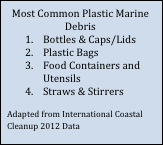 In coastal regions, storms are often powerful and accompanied by deluges of water that rush down hill into storm drains, ravines, streams and rivers, and ultimately to the sea. That water picks up much of the largely forgotten bottles, cans, and other trash that lies along curbs, under trees, in parks, and even in unsecured trashcans. It carries the debris into the waterways where it tangles in the bush alongside the stream bed or gets caught around rocks and bridge abutments, and eventually, forced by the currents, finds its way onto beaches and into marshes and other areas. After Hurricane Sandy, plastic bags decorated trees along the beachside roadways as high as the storm surge—more than 15 feet off the ground in many places, carried there by the water as it rushed back from the land to the sea.
In coastal regions, storms are often powerful and accompanied by deluges of water that rush down hill into storm drains, ravines, streams and rivers, and ultimately to the sea. That water picks up much of the largely forgotten bottles, cans, and other trash that lies along curbs, under trees, in parks, and even in unsecured trashcans. It carries the debris into the waterways where it tangles in the bush alongside the stream bed or gets caught around rocks and bridge abutments, and eventually, forced by the currents, finds its way onto beaches and into marshes and other areas. After Hurricane Sandy, plastic bags decorated trees along the beachside roadways as high as the storm surge—more than 15 feet off the ground in many places, carried there by the water as it rushed back from the land to the sea.
Island nations already have a big challenge when it comes to trash—land is at a premium and using it for landfills is not really practical. And – especially now in the Caribbean – they have another challenge when it comes to trash. What happens when a storm comes and thousands of tons of soggy debris is all that is left of people’s houses and beloved possessions? Where is it going to be put? What happens to the nearby reefs, beaches, mangroves, and seagrass meadows when the water brings to them much of that debris mixed with the sediment, sewage, household cleaning products, and other materials that were stored in human communities until the storm? How much debris does ordinary rainfall carry into streams and onto beaches and in nearby waters? What happens to it? How does it affect marine life, recreational enjoyment, and the economic activities that sustain communities on the islands?
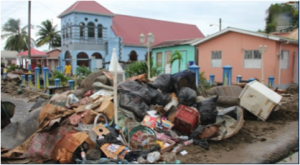 The Caribbean Environment Program of UNEP has long been aware of this problem: highlighting the issues on its website, Solid Waste and Marine Litter, and convening interested individuals around options for improving waste management in ways that reduce the harm to nearshore waters and habitats. The Ocean Foundation’s Grants and Research Officer, Emily Franc, attended one such convening last fall. Panelists included representatives from an array of governmental and non-governmental organizations.[1]
The Caribbean Environment Program of UNEP has long been aware of this problem: highlighting the issues on its website, Solid Waste and Marine Litter, and convening interested individuals around options for improving waste management in ways that reduce the harm to nearshore waters and habitats. The Ocean Foundation’s Grants and Research Officer, Emily Franc, attended one such convening last fall. Panelists included representatives from an array of governmental and non-governmental organizations.[1]
The tragic loss of life and community heritage in the Christmas Eve storms was just the start of the story. We owe it to our island friends to think ahead about other consequences of future storms. We know that just because this storm was unusual, it does not mean there will not be other unusual or even expected storm events.
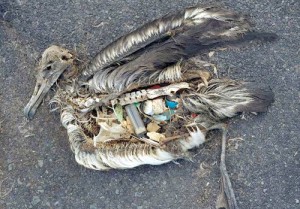 We also know that preventing plastics and other pollution from reaching the ocean should be our priority. Most plastic does not break down and go away in the ocean—it simply disintegrates into smaller and smaller parts, disrupting feeding and reproductive systems of ever-smaller animals and plants in the sea. As you may know, there are aggregations of plastic and other debris in the major gyres every ocean of the world—with the Great Pacific Garbage Patch (near the Midway Islands and covering the central North Pacific Ocean) being the most famous, but, sadly, not unique.
We also know that preventing plastics and other pollution from reaching the ocean should be our priority. Most plastic does not break down and go away in the ocean—it simply disintegrates into smaller and smaller parts, disrupting feeding and reproductive systems of ever-smaller animals and plants in the sea. As you may know, there are aggregations of plastic and other debris in the major gyres every ocean of the world—with the Great Pacific Garbage Patch (near the Midway Islands and covering the central North Pacific Ocean) being the most famous, but, sadly, not unique.
So, there’s one step we can all support: Reduce the manufacture of single-use plastics, promoting more sustainable containers and systems for delivering liquids and other products to where they will be used. We can also agree on a second step: Making sure that cups, bags, bottles, and other plastic trash are kept out of storm drains, ditches, streams and other waterways. We want to keep all plastic containers from winding up in the ocean and on our beaches.
- We can ensure that all trash is recycled or otherwise thrown out properly.
- We can participate in community clean ups to help get rid of the debris that can clog our waterways.
As we have said many times before, restoring coastal systems is another critical step to ensure resilient communities. The smart coastal communities who are investing in rebuilding these habitats to help prepare for the next serious storm are gaining recreational, economic, and other benefits as well . Keeping the trash off the beach and out of the water makes the community more appealing to visitors.
The Caribbean offers a diverse array of island and coastal nations to attract visitors from all over the Americas and the world. And, those in the travel industry need to care about the destinations their customers travel to for pleasure, business, and family. We all rely on its beautiful beaches, unique coral reefs, and other natural wonders to live, work, and play. We can come together to prevent harm where we can and address consequences, as we should.
[1] A number of organizations are working to educate, clean up, and identify solutions to plastic pollution in the ocean. They include Ocean Conservancy, 5 Gyres, Plastic Pollution Coalition, Surfrider Foundation, and many others.
